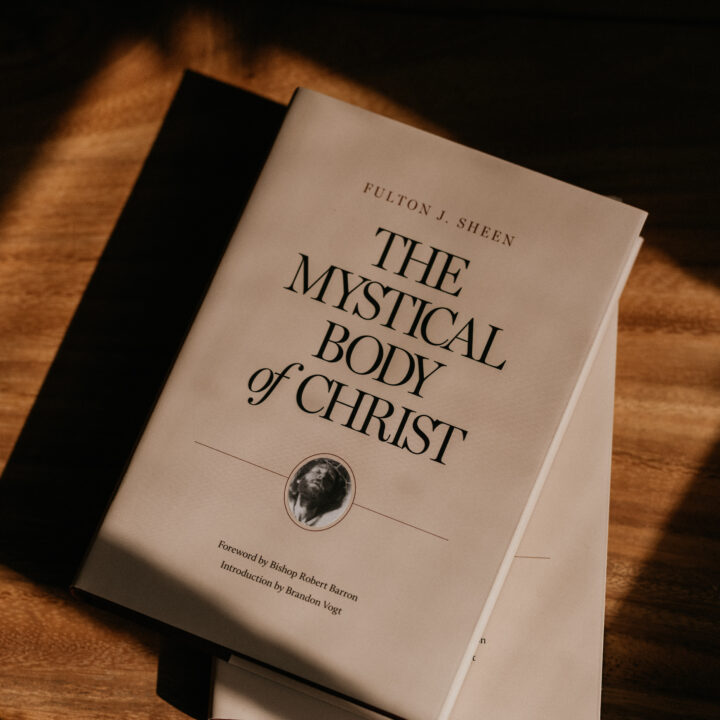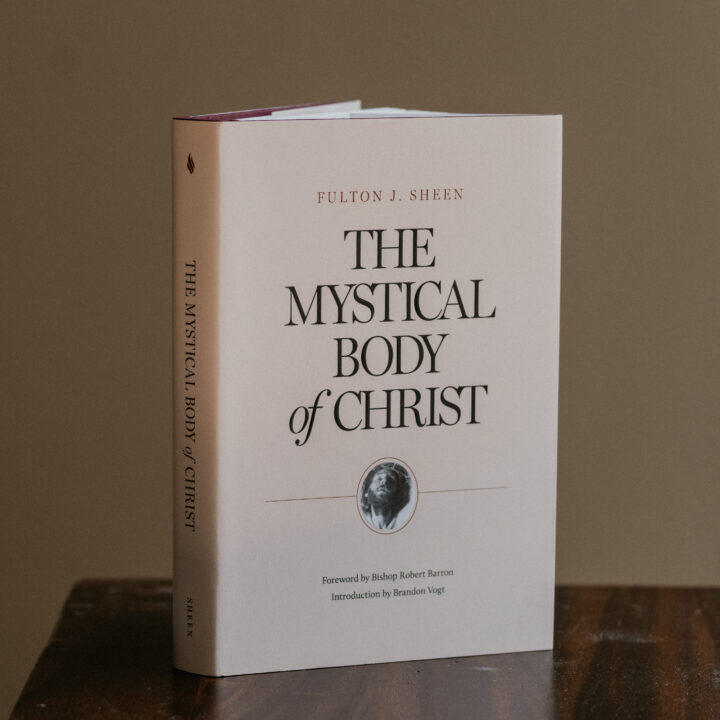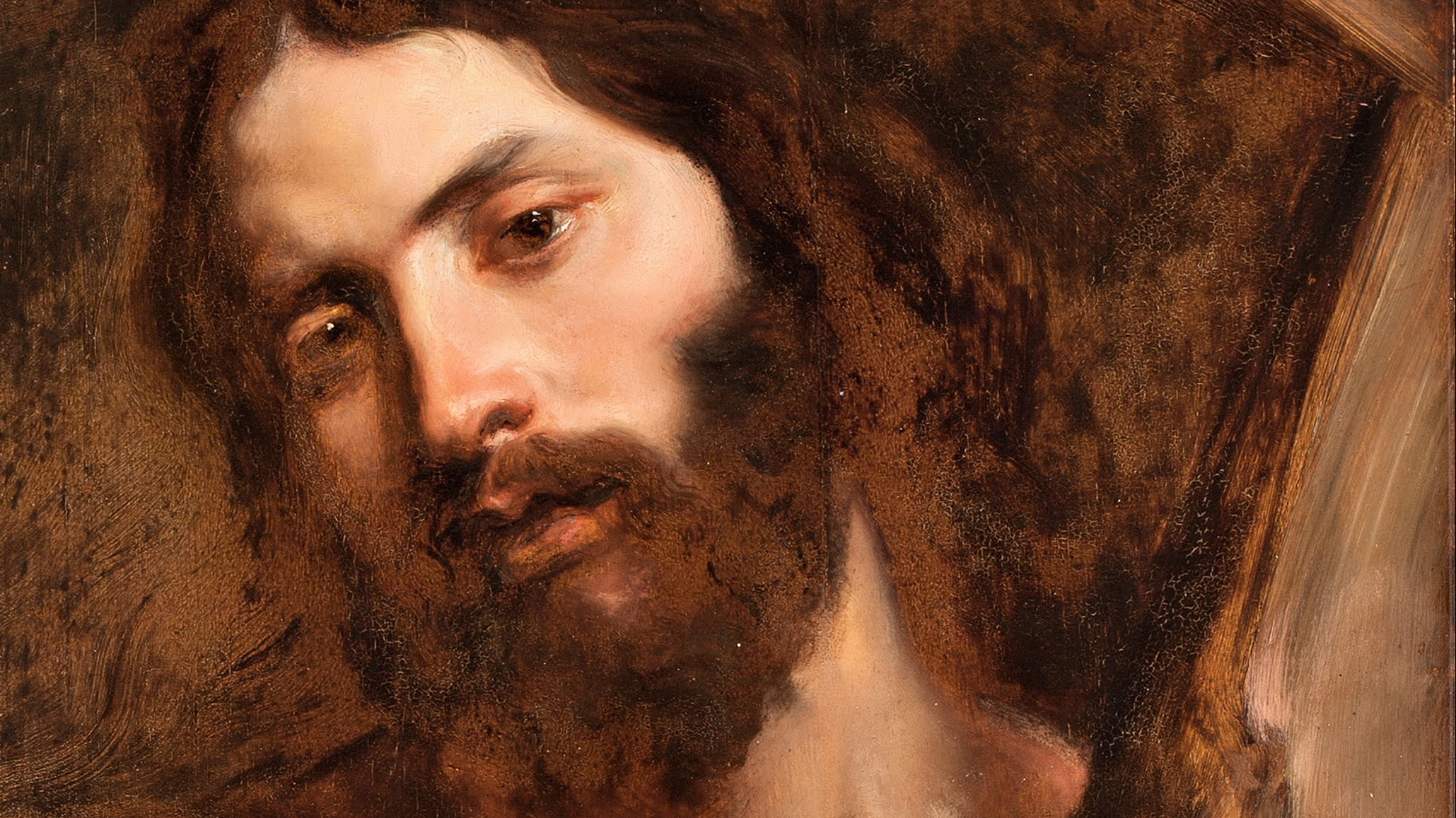
The following excerpt is sourced from pp. 12-17 from the chapter “The Whole Christ” in Archbishop Fulton J. Sheen’s The Mystical Body of Christ (Word on Fire Publishing).
First published in 1935, Bishop Barron provides the foreword in Word on Fire’s new edition of this groundbreaking contribution to ecclesiology. You can order this edition here bundled with Sheen’s classic, Life of Christ.
Our Lord does not live in the world to-day in exactly the same way as He lived in Galilee; forty days after His Resurrection He ascended into heaven where He sits at the right hand of the Father. He must live on earth to-day in a way different from His Life of nineteen hundred years ago, and in a way other than that in which He inhabits heaven. This new way is called His Mystical Life. There are therefore three phases in the complete Life of Christ or in the Life of the whole-Christ: first, His Earthly Life; second, His Glorified Life; third, His Mystical Life.
1. The Earthly Life
From all eternity the Second Person of the Blessed Trinity is eternally generated by the heavenly Father in the ecstasy of the first and real paternity: “Thou art My Son, this day have I begotten Thee.” It was because of this Eternal Life in the Godhead that He could say, “Before Abraham was, I am.” The Eternal generation of the Son of God has its temporal counterpart in the earthly generation of the Son of man in the womb of the Blessed Mother, of whom was born Jesus Christ, possessed of a Divine Nature from eternity, a human nature in time, and of both united in the oneness of the Person of the Son of God. This earthly Life began in the manger at Bethlehem, continued through the obedience of thirty years at Nazareth, the three years of teaching, the three hours on the cross, the three days in the grave, and the forty days of Risen Life before ascending into heaven, leaving us an example to walk in His steps. It was not a long Life, as we reckon a life; most of us would consider our work hardly begun at thirty. But it was a Life in which everything was accomplished according to His pre-ordained plan, neither hastened nor retarded by the iniquity of men. He came to give His Life for the Redemption of many, “laid it down” in the “hour of darkness” which He foretold, “took it up again” as He prophesied in the sign of Jonas, and then ascended into heaven, never again to be visible to the fleshly eyes of men. His earthly Life was finished.
2. The Glorified Life
The second phase of the complete Life of Christ is pursued in heaven. During the forty days which followed His Resurrection our Lord has completed His instructions concerning His Kingdom on earth, and now can say to His Father: “I have finished the work which Thou gavest Me to do, and now Glorify Thou Me, O Father, with the glory which I had, before the world was, with Thee” (John 17:4–5). The human nature taken from His pure Mother is ready to enjoy the reward of that earthly Life spent in obedience to the Father’s Will. On a Thursday, forty days after Easter, He assembles His apostles, leads them to the Mount of Olives, blesses them, and rises by His own Divine Power above the clouds, as He had told them: “Ought not Christ to have suffered these things and so enter into His glory?” (Luke 24:26). Even as the planets sweep round their orbit and return to their starting point as if to salute Him who sent them on their way, so Christ, completing the orbit of an earthly Life, returns to His heavenly Father to enjoy the glory which was His before the foundation of the world.
St. Paul, speaking of this Glorification of Jesus, writes to the Ephesians: “What is the exceeding greatness of [God’s] power toward us, who believe, according to the operation of the might of His power, which was wrought in Christ, raising Him up from the dead, and setting Him on the right hand in the heavenly places, above all principality, and power, and virtue, and dominion” (Eph. 1:19–21). The creed of the Church too describes Christ in His glory as “seated at the right hand of God.” This is no more than a figurative way of expressing the eternal repose merited by His glorious triumphs and the continued exercise of those Powers, which His Father had given Him, to teach, govern and sanctify man. For we must not picture our Lord in His glorified state as indifferent to the world which He had come to redeem (cf. John 14:2–4, 17:24).
There are two reasons for Christ’s Glorification. The first is because He is God’s own Son. “I came forth from the Father, and am come into the world. Again I leave the world, and I go to the Father” (John 16:28). The second is because He has humbled Himself and therefore shall be exalted. “Who emptied Himself, taking the form of a servant, being made in the likeness of men, and in habit found as a man. He humbled Himself, becoming obedient to death, even to the death of the cross. For which cause God also hath exalted Him, and hath given Him a name which is above all names: That in the name of Jesus every knee should bow, of those that are in heaven, on earth, and under the earth. And that every tongue should confess that the Son Jesus Christ is in the glory of God the Father” (Phil. 2:7–11).
3. The Mystical Life
This text of St. Paul brings us to the third phase of the Life of Christ, in which He begins again to live on earth in a new way, for He had told His apostles on the night of the Last Supper, “I will come again.” It was not best (He told them) that He abide with them in His visible earthly form, for He would thus be only something external to them, but if He left them to go to His Father and sent His Spirit, then He would be, not an example to be copied, but a Life to be lived. And so He said to them, while still in the flesh: “It is expedient to you that I go: for if I go not, the Paraclete will not come to you; but if I go, I will send Him to you” (John 16:7). The day of Pentecost, ten days after His Resurrection, was the birth of Christ’s new Life on earth, for on that day He sent His Spirit to His apostles, the nucleus of His Church, to make them, in the language of Holy Writ, His New Body, the Church of which He is the invisible Head (Rom. 8:9).
The new presence of Christ on earth in His Church is the third phase of the complete Life of Christ, and in order to demarcate it from His physical Life and from His Glorified Life tradition has called it the Mystical Life. Just as in His earthly Life He took a human body as an instrument for the exercise of His office as Prophet, King, and Priest, so now on Pentecost He assumes a new body, His Church, through the instrumentality of which He still fulfils the same triple role of teaching, governing, and sanctifying. In His earthly Life, He had only one human nature united to Him; in His Mystical Life, He unites to Himself all those human natures throughout the world who receive His Spirit. In His earthly Life, He was redeeming; in His Mystical Life, He is bestowing the fruits of Redemption on the members of His Mystical Body. In His earthly Life, He possessed the fullness of the Godhead; in His Mystical Life, we receive of Its fullness. In His earthly Life, He was the Founder of the Kingdom; in His Mystical Life, He incorporates us into that Kingdom. In His earthly Life, He suffered and rejoiced in His physical body; in His Mystical Life, He suffers and rejoices in His Mystical Body. Then He was the Vine, now He is the Vine giving life to the branches; then He was the Leaven, now He is the Leaven in the Mass; then He was the Mustard Seed, now He is the Tree of Life; then He had a body taken from the womb of the Blessed Mother overshadowed by the Holy Ghost, now He has a Mystical Body, the Church, taken from the womb of humanity overshadowed by the same Pentecostal Spirit. Of course, the Mystical union between the Christian and Christ is not the same as the union of His Divine and human natures in His person. The former is by grace and accidental, the latter is personal and substantial. Remember, we always speak with this understanding.
He has not left us orphans; He is with us and more intimately than we are with ourselves.
The complete Life of Christ must include these three phases. Those who consider His physical Life alone, either develop a sentimental spirituality or else end by regarding Him merely as a good man and a teacher of humanitarian ethics; those who consider Him only in His heavenly Life of glory, regard Him as an absentee landlord, disregarding both His promise to send His Spirit, and His abiding interest in the souls which He came to save. Just as it would be wrong to limit The New Testament to The Gospels, so it would be wrong to limit Christ to an earthly career. The Gospels are the record of His earthly Life, and the promise of the Glorified and Mystical Lives; The Acts of the Apostles and The Epistles of Paul, Peter, James, John and Jude are the records of the Mystical Life. Christ is not divided; He is not past; He has not left us orphans; He is with us and more intimately than we are with ourselves. He is still living in the world, moving amongst its poor, instructing the ignorant, comforting the doubtful, and healing the souls of men. Such is His Mystical Life in the Church. As His human and Divine natures are one in the unity of His Person in the Incarnation, so too in His Mystical Life the Church His Body and He the Head are one Person—the Mystical Christ. Christ is our contemporary.
It is within the power of man to prolong himself through space and time by doctrine and example. It is within Christ’s power to prolong Himself, not only by doctrine and example, but also by His Life. If you believe that He is God, you must believe this. If you do not believe that He is God, then you cannot believe Him to be a good man, for a good man does not lie, and He said that He was God. But if you do believe that He is God and consequently that He has projected His Life through all time and throughout the world, then you must seek out that Divine Life. You must discover where It is. And it must be very definitely somewhere, for life is not something vague and undefined like a fog. If that Life is on this earth, it must be found in some organism, since life on earth is never found divorced from a body.

You can order Archbishop Fulton J. Sheen’s The Mystical Body of Christ (Word on Fire Publishing) with a foreword by Bishop Barron and a bonus copy of Sheen’s classic Life of Christ here from Word on Fire.
